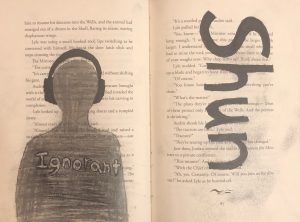The glossument book named “What Lando Found” consists of illustrations based on vocabulary words. This project is inspired by “A Humument” made by Tom Phillip. Olando feels as if he can upgrade the aspect of any book and turn it into his own. As a creative person Olando can describe himself as a blind visionary. It’s understood that as a creative person Olando must be able to turn nothing into something. He also understand that creativity is the infusion of different aspects. This glossument project was made through many aspects such as creativity, inspiration, tools, motivations, and many different themes such as opposition and dullness.
Olando’s main inspiration was a video on blackout poetry that he seen on youtube. Also Olando seen articles on the internet about drawing pictures based on vocabulary words. This inspiration came from his class project called “A glossument”. He was also inspired by his own motives to draw pictures that relates the the vocabulary of words and to make every other word relate to each other through his drawings. This book is also more inspired in his strive to get towards greatness and uniqueness.
The motivations for this book were mainly tools. Olando tried to experiment with different shaded pencils and he also used blades and exacto knives to cut out some pages to make them more appealing towards the audiance. He did many shapes and creative cut throughs. For example Olando cut through his pages to make the cut spaces look like doors and windows. I also used cut outs from magazines to try make the book more colorful since he’s not really into using paint. Olando also used glue to make things stick to where they belong. The tools used played a big part in his glossument.
The theme of Olando’s book is opposition. He wanted things to seem either authentic or fabricated in his own book. He choose this theme because he feels as if opposites make things in reality balance out, Examples like white and black, up and down, and left and right. So in Olando’s head he thought why not make things balanced out in his creative book. Olando just wanted to develop more techniques as he continues on with his blasphemous book.







